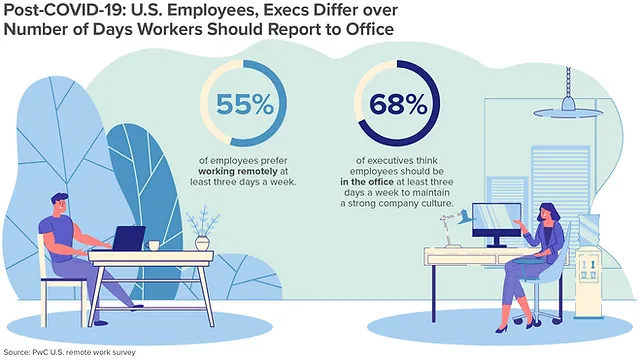Welcome to the topic “Designing Commercial Offices For Hybrid Workers“
Commercial hybrid offices are definitely the need of the time. As the world adapts to the new normal of hybrid working, where employees split their time between working remotely and commuting to the office a few times a week, commercial real estate offices are undergoing a significant transformation.
The traditional office setup is being reimagined to accommodate the needs and preferences of hybrid workers, creating an environment that fosters productivity and employee well-being. Hybrid working is a concept that has gained immense popularity in recent years, and for good reason.
It offers employees the flexibility to work from home while still having the opportunity to connect with colleagues in a physical workspace. This model promotes a healthy work-life balance and boosts employee morale and satisfaction.

With this flexible form of working, designing hybrid office space needs to evolve accordingly. Gone are the days of rows of cubicles and rigid workstations. Instead, offices are now being designed with a more open and flexible layout, incorporating collaborative spaces, comfortable breakout areas, and technology-enabled meeting rooms.
Everything To Consider In Designing Commercial Offices For Hybrid Workers
Designing a hybrid commercial office space that caters to the needs of employees who work both remotely and in the office is essential in embracing the new normal of hybrid working. There are several factors to consider when designing such a workspace to ensure maximum productivity and satisfaction for both remote and in-office workers.
As companies adapt to the changing dynamics of work, it becomes essential to design office spaces that accommodate both remote work and in-person collaboration effectively. Here are some key considerations to create a successful hybrid commercial office space.
Flexibility In Layout
Design the office space with flexible layouts that can easily adapt to changing needs. Incorporate movable furniture, modular partitions, and adjustable desks to allow employees to personalize their workstations based on their preferences and tasks.
Interactive Zones
Create dedicated collaboration areas where employees can come together for brainstorming, meetings, and group work. These zones should be equipped with technology and tools that facilitate seamless virtual interactions, ensuring that remote workers can actively participate and contribute.
By providing these zones, businesses can promote both formal and informal communication, facilitating the exchange of knowledge and fueling innovation.
Technology Integration
With employees splitting their time between the office and remote locations, technology becomes an essential tool for seamless communication.
Invest in advanced technology infrastructure and video conferencing systems to support virtual meetings and ensure smooth communication between remote and in-office employees. High-speed internet connectivity, reliable audio and video equipment, and user-friendly interfaces are essential to foster seamless hybrid work experiences.

Wellness Spaces
Hybrid commercial office space should also take into consideration the changing needs and expectations of employees in terms of amenities and facilities. Traditional office spaces often provide basic amenities such as cafeterias and restrooms. However, in hybrid offices, the focus is on creating a more holistic and inclusive environment.
Prioritize employee well-being by incorporating wellness spaces within the office. Designate areas for relaxation, meditation, or physical activities to encourage a healthy work-life balance. Hybrid workers can utilize these spaces during their office days to rejuvenate and maintain productivity.
Providing ergonomic furniture, ample natural light, and incorporating green elements can also contribute to creating a healthy and invigorating work environment. Encouraging movement through the integration of standing desks, adjustable seating options, and designated areas for physical activity or relaxation can also contribute to the overall well-being of employees.
Efficient Resource Allocation
With a reduced number of employees in the office on any given day, optimizing the utilization of resources becomes imperative. Optimize the use of office space by considering agile working arrangements. Implement shared workstations, hot-desking, or hoteling concepts to accommodate employees who are only present in the office a few days a week. This approach maximizes space utilization and reduces real estate costs.
Communication And Transparency
With employees spending fewer days in the office, it is essential to establish clear channels of communication to keep everyone connected and informed, regardless of their physical location.
This can include leveraging digital collaboration tools, such as video conferencing platforms or project management software, to facilitate seamless communication between in-office and remote employees. Transparent communication ensures that everyone stays on the same page, aligns with company goals, and feels connected to the overall organizational culture.
Encourage open dialogue and involve employees in the decision-making process. Transparent communication fosters a sense of inclusivity and ensures that their needs are considered during the design and implementation phases.

Why Designing Commercial Offices For Hybrid Workers Should Be A Priority?
Creating a hybrid office space entails striking a delicate balance between fostering collaboration and productivity while also providing the necessary amenities and flexibility for employees who commute to the office a few times a week. This calls for a thoughtful and strategic approach to office design. Remember, a commercial hybrid office space caters to a different set of work ethics. This is primarily why traditional office designs won’t work in this case.
In a traditional office, each employee would have their own dedicated workspace, such as a cubicle or an assigned desk. However, in a hybrid office setting, the concept of individual workstations needs to be reconsidered. Instead of assigning specific workspaces to each employee, hybrid offices are designed to offer a more flexible and collaborative environment.
This means incorporating shared workspaces, hot-desking areas, and comfortable breakout areas where employees can choose where they want to work based on their needs for that particular day. This not only maximizes efficiency but also encourages interaction among team members.
You have to think about workplace utilization, too. With employees only commuting to the office three times a week, the demand for desk space has reduced significantly. This shift allows for more flexible and efficient use of space, where businesses can optimize their office layouts and focus on creating interactive environments.
Hybrid Office Spaces Are The Future
Let’s face it. Hybrid office spaces are no longer a temporary solution; they are here to stay, and the commercial real estate industry must adapt accordingly. As more and more companies adopt hybrid work models, it’s crucial to create workspaces that cater to the needs of employees who split their time between remote work and office attendance.
Companies are reimagining their office spaces to foster connectivity, engagement, and productivity for hybrid workers. And the commercial real estate sector needs to meet this demand.
Embracing flexibility, collaboration, advanced technology, and employee well-being is crucial in creating office environments that foster productivity, engagement, and success in this new era of work. The transformation of commercial real estate offices is essential for companies to thrive in the hybrid working model and embrace the new normal of work-life balance.
Creating a successful hybrid office environment involves a thoughtful approach to space utilization and design. The future of work is here, and commercial real estate offices are leading the way in designing the workplace for the hybrid workforce. This is not the time to hold onto traditional ideas but instead to let your creativity get ahead. Hybrid office spaces provide the commercial real estate sector an opportunity to be innovative like never before.
Also read: Women In Commercial Real Estate
TAGS